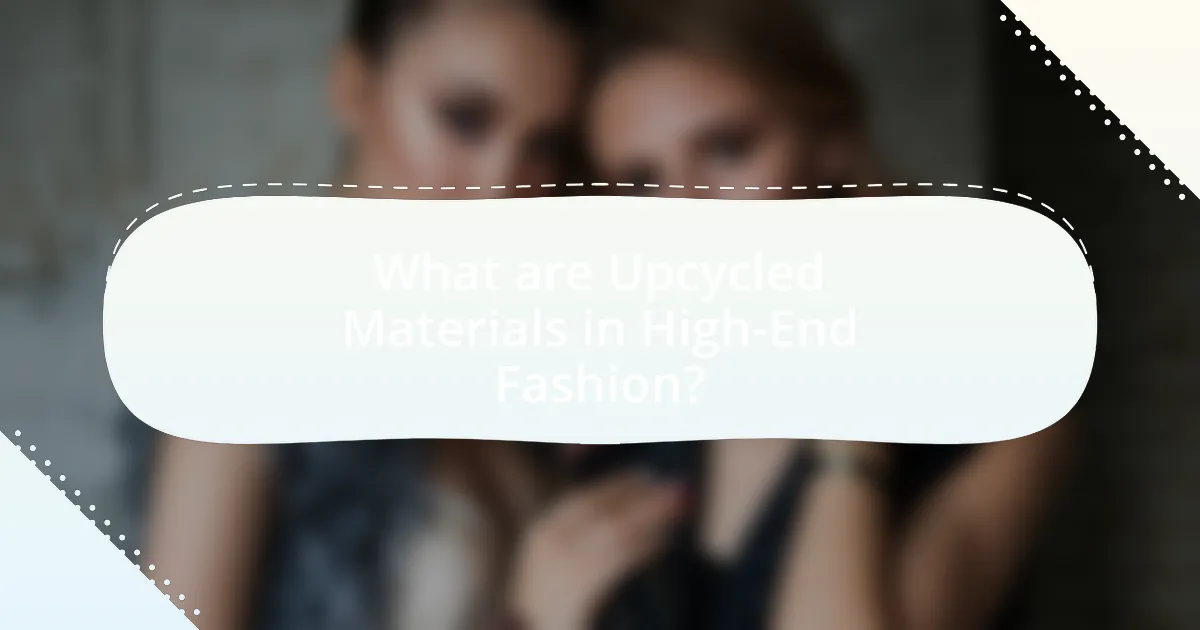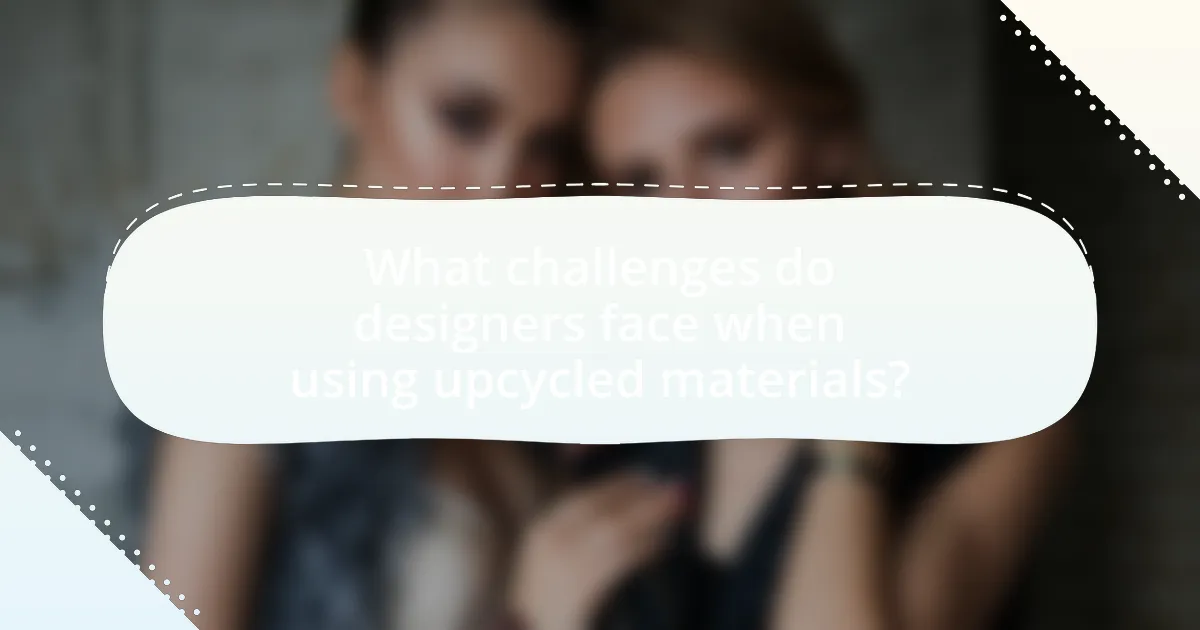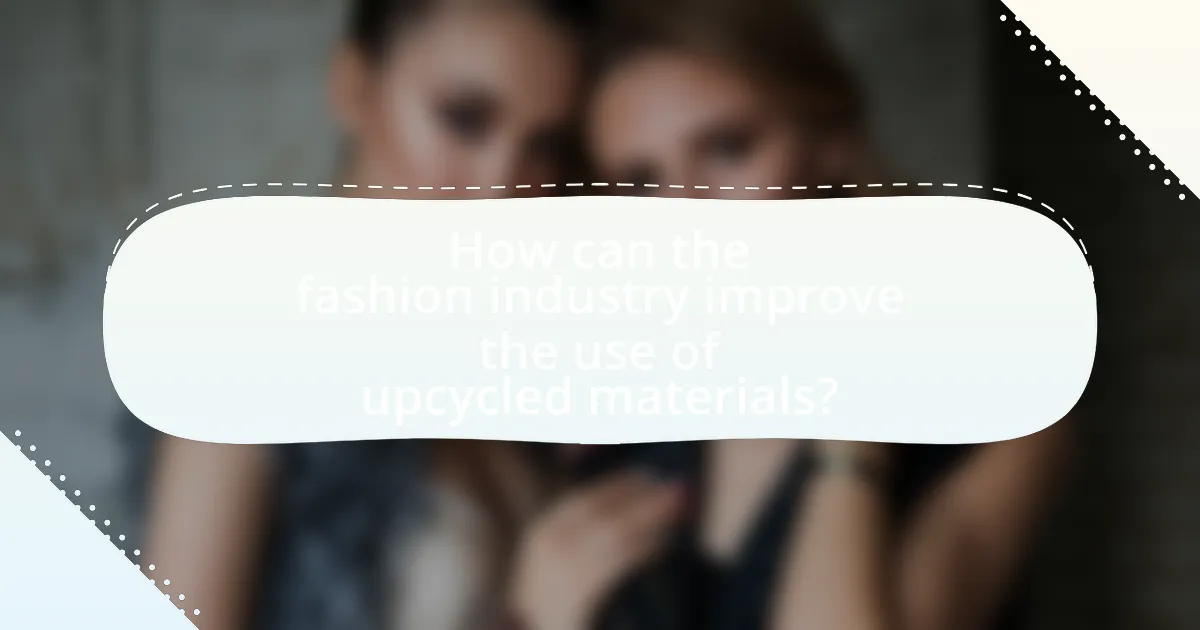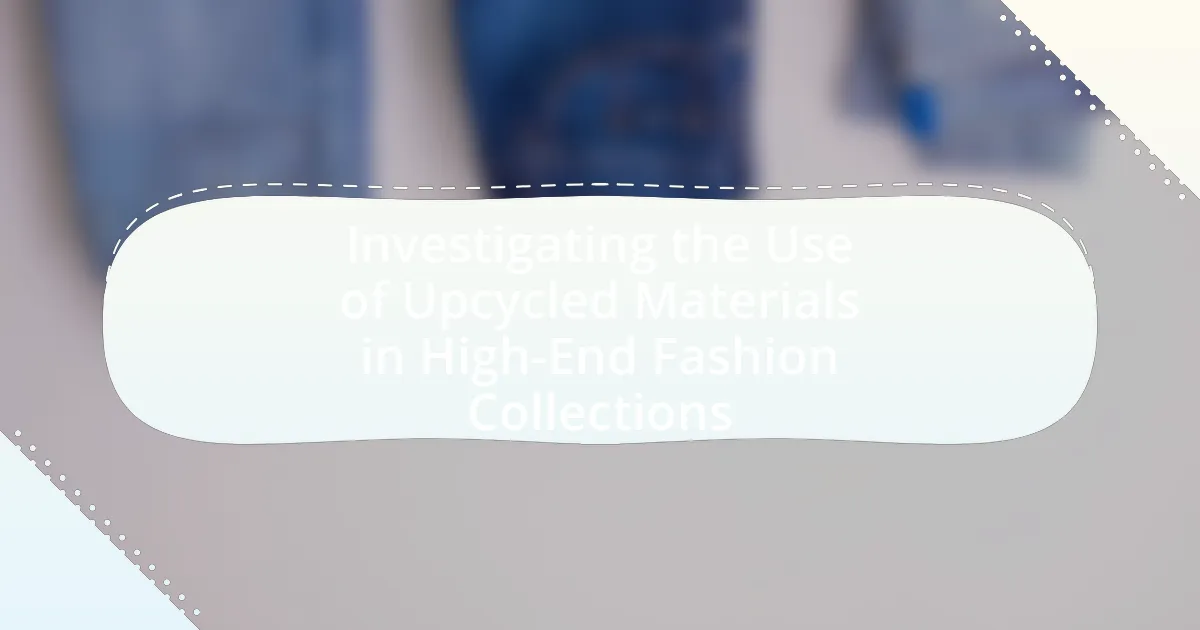The article investigates the use of upcycled materials in high-end fashion collections, highlighting their role in promoting sustainability and reducing waste. Upcycled materials, which include repurposed textiles and industrial waste, are creatively transformed into unique fashion items by luxury brands such as Stella McCartney and Gucci. The discussion covers the definition of upcycled materials, the types commonly used, the importance of upcycling for sustainability, and the aesthetic benefits it brings to fashion. Additionally, it addresses the challenges designers face in sourcing and ensuring the quality of these materials, as well as consumer perceptions and trends driving demand for upcycled fashion. The article concludes with insights on future trends and innovations in the upcycling process within the fashion industry.

What are Upcycled Materials in High-End Fashion?
Upcycled materials in high-end fashion are repurposed textiles and other materials that have been creatively transformed into new fashion items, reducing waste and promoting sustainability. This practice involves taking discarded or surplus materials, such as vintage fabrics, deadstock, or even industrial waste, and reimagining them into unique, high-quality garments or accessories. The use of upcycled materials not only minimizes environmental impact but also adds a distinctive character to fashion collections, as each piece often carries a story or history. High-end brands like Stella McCartney and Gucci have incorporated upcycling into their collections, showcasing the potential for luxury fashion to embrace sustainable practices while maintaining aesthetic appeal.
How are upcycled materials defined in the context of fashion?
Upcycled materials in the context of fashion are defined as textiles and other materials that have been repurposed or transformed from their original use into new products, thereby extending their lifecycle and reducing waste. This practice not only minimizes environmental impact but also promotes creativity and innovation within the fashion industry. For instance, according to a report by the Ellen MacArthur Foundation, upcycling can significantly reduce the carbon footprint associated with textile production, as it utilizes existing materials rather than requiring new resources.
What types of materials are commonly upcycled in fashion collections?
Commonly upcycled materials in fashion collections include denim, leather, cotton, and polyester. Denim is frequently repurposed due to its durability and widespread availability, often transformed into new garments or accessories. Leather, sourced from discarded items like jackets or bags, is upcycled to create unique fashion pieces. Cotton, particularly from old t-shirts or sheets, is utilized for its versatility and comfort, while polyester, derived from plastic bottles or discarded garments, is increasingly used in sustainable fashion. The practice of upcycling these materials not only reduces waste but also promotes environmental sustainability in the fashion industry.
Why is upcycling important for sustainability in fashion?
Upcycling is important for sustainability in fashion because it reduces waste and minimizes the demand for new resources. By transforming discarded materials into new products, upcycling diverts textiles from landfills, where they contribute to environmental pollution. According to the Ellen MacArthur Foundation, the fashion industry is responsible for 92 million tons of waste annually, highlighting the urgent need for sustainable practices. Upcycling not only conserves resources but also promotes creativity and innovation within the fashion industry, allowing designers to create unique pieces while addressing environmental concerns.
What role do upcycled materials play in high-end fashion collections?
Upcycled materials play a crucial role in high-end fashion collections by promoting sustainability and reducing waste. Designers increasingly incorporate these materials to create unique, one-of-a-kind pieces that appeal to environmentally conscious consumers. For instance, brands like Stella McCartney and Gucci have successfully integrated upcycled textiles into their collections, showcasing the aesthetic potential of repurposed materials while also addressing the fashion industry’s environmental impact. This approach not only enhances brand image but also aligns with the growing consumer demand for sustainable practices, as evidenced by a 2021 McKinsey report indicating that 67% of consumers consider sustainability when making a purchase.
How do designers incorporate upcycled materials into their collections?
Designers incorporate upcycled materials into their collections by sourcing discarded textiles, garments, and other materials to create new fashion items. This practice not only reduces waste but also promotes sustainability within the fashion industry. For instance, brands like Stella McCartney and Reformation have successfully integrated upcycled fabrics into their lines, demonstrating that high-quality fashion can be achieved through responsible sourcing. According to a report by the Ellen MacArthur Foundation, the fashion industry could reduce its environmental impact significantly by adopting circular practices, including the use of upcycled materials.
What are the aesthetic benefits of using upcycled materials in high-end fashion?
The aesthetic benefits of using upcycled materials in high-end fashion include unique designs, enhanced texture, and a narrative quality that resonates with consumers. Upcycled materials often possess distinct characteristics that differentiate them from conventional fabrics, allowing designers to create one-of-a-kind pieces that stand out in the luxury market. For instance, the use of vintage textiles can introduce rich patterns and colors that are not readily available in new materials. Additionally, the tactile qualities of upcycled materials can add depth and interest to garments, appealing to consumers’ senses. Furthermore, the story behind each upcycled piece can enhance its emotional value, as consumers increasingly seek products that reflect sustainability and individuality. This trend is supported by research indicating that 66% of consumers are willing to pay more for sustainable brands, highlighting the growing appreciation for the aesthetic and ethical dimensions of upcycled fashion.
Why is the use of upcycled materials gaining popularity in the fashion industry?
The use of upcycled materials is gaining popularity in the fashion industry due to increasing consumer demand for sustainable practices and environmental consciousness. As awareness of the negative impacts of fast fashion grows, brands are responding by incorporating upcycled materials to reduce waste and promote eco-friendly alternatives. For instance, a report by McKinsey & Company highlights that 66% of global consumers are willing to pay more for sustainable brands, indicating a significant market shift towards sustainability. This trend not only aligns with consumer values but also helps brands differentiate themselves in a competitive market, making upcycling a strategic choice for many fashion companies.
What consumer trends are driving the demand for upcycled fashion?
The demand for upcycled fashion is primarily driven by increasing consumer awareness of sustainability and environmental impact. Consumers are increasingly prioritizing eco-friendly practices, with a 2021 survey indicating that 66% of global consumers are willing to pay more for sustainable brands. Additionally, the rise of the circular economy concept encourages consumers to seek out products that minimize waste, further boosting interest in upcycled fashion. The trend is also supported by a growing desire for unique, one-of-a-kind pieces, as upcycled items often offer distinct styles that differentiate them from mass-produced clothing.
How do luxury brands benefit from adopting upcycled materials?
Luxury brands benefit from adopting upcycled materials by enhancing their sustainability profile and appealing to environmentally conscious consumers. This approach allows these brands to reduce waste and lower their carbon footprint, aligning with the growing demand for eco-friendly practices in the fashion industry. According to a 2021 McKinsey report, 67% of consumers consider sustainability when making a purchase, indicating that luxury brands can attract a larger customer base by integrating upcycled materials into their collections. Additionally, using upcycled materials can differentiate luxury brands in a competitive market, as it showcases innovation and commitment to responsible sourcing.

What challenges do designers face when using upcycled materials?
Designers face several challenges when using upcycled materials, primarily related to material quality, consistency, and sourcing. The variability in the quality of upcycled materials can lead to difficulties in achieving the desired aesthetic and durability in fashion collections. For instance, materials may have different wear patterns, colors, or textures, which can complicate the design process. Additionally, sourcing upcycled materials can be inconsistent, as availability often depends on local waste streams and recycling practices, making it challenging for designers to plan collections effectively. According to a study by the Ellen MacArthur Foundation, the lack of standardized processes for upcycling can hinder scalability and efficiency in production, further complicating the designer’s workflow.
How do quality and availability affect the use of upcycled materials?
Quality and availability significantly influence the use of upcycled materials in high-end fashion collections. High-quality upcycled materials ensure durability and aesthetic appeal, which are crucial for luxury brands aiming to maintain their reputation. For instance, materials that are well-preserved and possess desirable characteristics, such as unique textures or colors, are more likely to be selected for upscale designs. Conversely, limited availability of high-quality upcycled materials can restrict designers’ options, leading to challenges in sourcing suitable fabrics that meet their standards. Research indicates that brands often face difficulties in finding consistent supplies of premium upcycled materials, which can hinder their ability to innovate and create exclusive collections. Thus, both the quality and availability of upcycled materials directly impact the feasibility and creativity of incorporating them into high-end fashion.
What are the sourcing challenges for designers working with upcycled materials?
Designers working with upcycled materials face several sourcing challenges, primarily related to the availability and consistency of materials. The irregular supply of upcycled materials can hinder production timelines, as these materials are often sourced from discarded items that vary in quantity and quality. Additionally, designers may struggle to find suitable materials that meet their aesthetic and functional requirements, as the nature of upcycling involves working with pre-existing items that may not always align with design specifications. Furthermore, the lack of standardized sourcing channels for upcycled materials complicates the procurement process, making it difficult for designers to establish reliable partnerships with suppliers.
How can designers ensure the quality of upcycled materials?
Designers can ensure the quality of upcycled materials by conducting thorough assessments of the source materials before use. This involves evaluating the physical condition, durability, and potential for wear of the materials, as well as verifying their provenance to ensure they meet safety and environmental standards. For instance, designers can perform tests for structural integrity and chemical safety, which are critical in determining the usability of materials in high-end fashion. Additionally, industry standards such as those set by the Global Organic Textile Standard (GOTS) provide guidelines for assessing the quality of recycled textiles, ensuring that they are suitable for high-quality fashion applications.
What are the perceptions of consumers regarding upcycled fashion?
Consumers generally perceive upcycled fashion positively, viewing it as a sustainable and environmentally friendly alternative to traditional fashion. This perception is supported by a growing awareness of environmental issues, with studies indicating that approximately 66% of consumers are willing to pay more for sustainable brands. Additionally, upcycled fashion is often associated with uniqueness and creativity, as each piece is typically one-of-a-kind, appealing to consumers who value individuality in their clothing choices.
How do consumers differentiate between upcycled and traditional materials?
Consumers differentiate between upcycled and traditional materials primarily through the origin and processing of the materials. Upcycled materials are derived from pre-existing products that have been repurposed or transformed into new items, often with an emphasis on sustainability and reducing waste. In contrast, traditional materials are typically sourced from raw resources and manufactured through conventional processes.
For example, a study by the Ellen MacArthur Foundation highlights that consumers are increasingly aware of the environmental impact of their purchases, leading them to seek out products made from upcycled materials as a more eco-friendly option. This awareness is further supported by market trends indicating a growing preference for sustainable fashion, with 66% of global consumers willing to pay more for sustainable brands, according to a Nielsen report.
What misconceptions exist about upcycled fashion collections?
One misconception about upcycled fashion collections is that they lack quality and style compared to traditional fashion. This belief stems from the assumption that using discarded materials inherently results in inferior products. However, many high-end designers, such as Stella McCartney and Vivienne Westwood, have successfully demonstrated that upcycled fashion can be both luxurious and stylish, often incorporating innovative design techniques and high-quality craftsmanship. Additionally, a study by the Ellen MacArthur Foundation highlights that upcycled materials can reduce environmental impact while maintaining aesthetic appeal, further debunking the myth of poor quality in upcycled fashion.

How can the fashion industry improve the use of upcycled materials?
The fashion industry can improve the use of upcycled materials by implementing standardized processes for sourcing and integrating these materials into production. By establishing clear guidelines and best practices, brands can ensure consistency and quality in upcycled products. For instance, companies like Reformation have successfully adopted a model that prioritizes the use of surplus fabrics and post-consumer waste, demonstrating that upcycling can be both sustainable and commercially viable. Additionally, investing in technology for material identification and processing can enhance the efficiency of upcycling efforts, as seen in initiatives like the Circular Fibres Initiative, which aims to create a circular economy in textiles.
What best practices can designers adopt for successful upcycling?
Designers can adopt several best practices for successful upcycling, including thorough material assessment, innovative design thinking, and collaboration with local artisans. Conducting a detailed evaluation of available materials allows designers to identify potential for reuse and transformation, ensuring that the upcycled products maintain quality and aesthetic appeal. Innovative design thinking encourages the exploration of unconventional uses for materials, which can lead to unique and marketable fashion items. Collaboration with local artisans not only supports community economies but also brings diverse skills and perspectives into the design process, enhancing the creativity and authenticity of upcycled collections. These practices are essential for creating sustainable and appealing high-end fashion that resonates with environmentally conscious consumers.
How can collaboration enhance the use of upcycled materials in fashion?
Collaboration can enhance the use of upcycled materials in fashion by pooling resources, expertise, and creativity from multiple stakeholders, including designers, manufacturers, and environmental organizations. This collective effort can lead to innovative design solutions that effectively utilize discarded materials, thereby increasing the overall sustainability of fashion products. For instance, partnerships between fashion brands and recycling companies can streamline the sourcing of upcycled materials, making them more accessible and cost-effective. Additionally, collaborative projects often raise awareness and educate consumers about the benefits of upcycling, which can drive demand for sustainable fashion. Research indicates that brands that engage in collaborative sustainability initiatives can see a 20% increase in consumer interest and sales, demonstrating the tangible benefits of such partnerships in promoting upcycled materials.
What role does education play in promoting upcycled fashion practices?
Education plays a crucial role in promoting upcycled fashion practices by equipping individuals with the knowledge and skills necessary to creatively repurpose materials. Educational programs focused on sustainability and fashion design teach students about the environmental impact of textile waste and the benefits of upcycling, fostering a mindset that values resourcefulness and innovation. For instance, institutions like the London College of Fashion offer courses specifically on sustainable fashion, highlighting techniques for upcycling and encouraging students to develop collections that utilize discarded materials. This educational foundation not only cultivates a new generation of designers committed to sustainable practices but also raises awareness among consumers about the importance of upcycled fashion, ultimately driving demand for such products.
What future trends can we expect in upcycled high-end fashion?
Future trends in upcycled high-end fashion will likely include increased integration of technology, such as digital design tools and blockchain for transparency, alongside a focus on circular economy principles. As consumer demand for sustainability grows, brands are expected to adopt innovative upcycling techniques that enhance the aesthetic appeal and functionality of garments, utilizing waste materials creatively. For instance, a report by McKinsey & Company highlights that the global fashion industry is projected to shift towards more sustainable practices, with upcycling becoming a key strategy to reduce waste and environmental impact. This trend is further supported by the rise of eco-conscious consumers, who are increasingly prioritizing brands that demonstrate a commitment to sustainability and ethical production.
How might technology influence the upcycling process in fashion?
Technology significantly influences the upcycling process in fashion by enabling innovative design techniques and efficient material processing. Advanced technologies such as 3D printing allow designers to create new garments from recycled materials with precision, reducing waste and enhancing creativity. Additionally, digital platforms facilitate the sourcing of upcycled materials, connecting designers with suppliers and consumers more effectively. For instance, the use of AI in inventory management helps brands optimize their resources, ensuring that surplus materials are utilized rather than discarded. These technological advancements not only streamline the upcycling process but also promote sustainability within the fashion industry, as evidenced by brands increasingly adopting these methods to meet consumer demand for eco-friendly practices.
What innovations are emerging in the use of upcycled materials?
Innovations in the use of upcycled materials include the development of advanced textile technologies that transform waste into high-quality fabrics, such as the creation of biodegradable materials from discarded plastics and the use of 3D printing to produce fashion items from upcycled resources. For instance, brands like Stella McCartney have pioneered the use of regenerated nylon made from ocean waste, demonstrating a commitment to sustainability while maintaining luxury standards. Additionally, the integration of digital design tools allows designers to efficiently utilize leftover materials, minimizing waste and maximizing creativity in high-end fashion collections.
What practical tips can designers follow when incorporating upcycled materials?
Designers can effectively incorporate upcycled materials by first assessing the quality and suitability of the materials for their intended use. This involves examining the structural integrity and aesthetic appeal of the upcycled items, ensuring they align with the design vision. Additionally, designers should establish a clear sourcing strategy, identifying reliable suppliers or local sources for upcycled materials, which can enhance sustainability and reduce carbon footprint.
Moreover, integrating upcycled materials requires creativity in design; designers should experiment with different combinations and techniques to showcase the unique characteristics of the materials. For instance, using contrasting textures or colors can create visually striking pieces. Lastly, documenting the story behind the upcycled materials can add value and authenticity to the final product, appealing to consumers who prioritize sustainability. This approach is supported by the growing consumer demand for eco-friendly fashion, as evidenced by a 2021 McKinsey report indicating that 67% of consumers consider sustainability when making purchasing decisions.

Leave a Reply